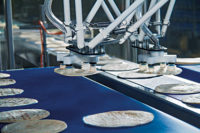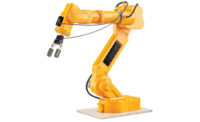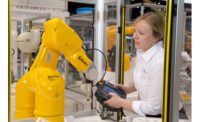Marketplace trends are fueling the expansion of robotics in the baking and snack industries. While robots are primarily being used by bakers and snack manufacturer to package product, they have many other uses, thanks to machine vision and interface tools.
More bakers and snack food manufacturers are using robotic systems for packaging. Marketplace trends are prompting these food manufacturers to try to create unique value for their products by changing product forms and packaging structures to suit consumer needs and wants.
“We are moving from a mass production era to a mass customization era,” says Shishir Rege, product marketing manager for consumer product goods, Yaskawa America Inc., Motoman Robotics Division, Miamisburg, Ohio.
Some of the tasks for which bakers and snack producers are using robotic systems include:
• High-speed visual inspection and sorting of cookies, snack bars and similar products.
• Re-orienting and collating randomly oriented baked goods as they’re unloaded from cooling conveyors or freezers to feed form/fill/seal machines.
• Case packing individual packets, multipacks or variety packs.
• Stacking or palletizing trays and cases.
• Pick and place—selecting various products to load into a primary package or to build a pallet load.
Inherently flexible
“Without robotics, product or packaging changes [on the line] can mean costly changeovers,” Rege says. “Robots are inherently flexible devices and can juggle several variations at the same time or batch. This capability also fits because contract packaging is on the rise, and manufacturers must be able to quickly adjust packaging lines to suit a wide range of products.”
Dick Motley, senior account manager, packaging integration network, for Fanuc America, Rochester Hills, Mich., sees several other factors driving the use of robotic systems throughout the food-processing industry:
• More options for food-grade robotics, from high-speed Delta/spider robots to articulated arms, through case packing and palletizing.
• Increased sophistication of machine vision to enable more advanced applications.
• Enhanced interface tools for seamless integration to other line equipment.
• Advances in safety technology for both personnel and equipment.
With the increasing power of PC-based control, it’s possible to implement more control tasks on a single hardware device. This is a game changer for cost-sensitive applications because it eliminates the standalone robot controller and the costs associated with such a specialized device, according to Joe Martin, packaging and converting sales manager, at Beckhoff Automation, Savage, Minn.
“The benefits of this reduction in hardware ripples throughout the line in the form of faster changeovers, reduced parts management, less software platforms to manage, streamlined networking and fewer points of failure,” he says. “With PC-based machine controls, [original equipment manufacturers] can design machines that incorporate the robotic functions needed for primary and secondary packaging, while decreasing the cost and size of the machine. The PC is built to handle data, so by using the multiple core technology available, bakery and snack food plant managers can access information from the machine in real time.”
Vision system virtues
Robots and vision systems are getting both smarter and faster. In a vision-guided robotics system, the vision system communicates with the robot, usually at a high speed, and updates package location and orientation. In a multi-robot system, the vision system and scheduling algorithms decide which robot will handle which part.
“The key virtue of vision-guided robotics is that they combine several exclusive operations in one,” adds Rege. “For example, inspection, sorting and picking used to be separate operations. Now, they can all be done at a single, vision-guided workcell, while the parts are still moving on a conveyor. This brings significant efficiency to the line.”
The latest robotic systems are self-monitoring, experts agree. “The latest robotic diagnostic software cannot only analyze errors that have already occurred and provide troubleshooting tips, it also can monitor system performance to provide predictive tools to address maintenance needs before errors occur,” Motley notes.
Today, computer simulation of robot performance can be used to evaluate potential applications for automation. “Basic calculations using spreadsheets can go a long way to making high-level estimates at robotic system rates,” observes Matt Wicks, vice president, product development, manufacturing systems, for Intelligrated, Mason, Ohio. “Simulation software offers the ability to take into account variables such as the robotic kinematics limitations or the interconnectedness of other processes in the system that would be too challenging to calculate manually.”
Up to the challenge
Despite the growing use of robotics, bakeries and snack manufacturing facilities pose challenges to companies that design and manufacture these systems. But these equipment manufacturers are ready to address customers’ needs.
Packaging variations are one challenge, according to Wicks. “Beyond the geometry of the products, the material and labeling of these variations present many challenges. Intelligrated manufactures custom robotic tooling to support the demands of these applications,” he notes.
When handling primary packaging for unwrapped products, there are many challenges in developing robot end-effectors (using vacuum or grippers) to keep from damaging or distorting delicate products, says Jerry Buckley, Midwest regional sales manager, BluePrint Automation, Colonial Heights, Va. There are also challenges in discharging crumbs or product debris when using vacuum devices on unwrapped baked products. “There also are challenges in handling wrapped products that may be fragile or have toppings that can be disturbed,” he adds.
Among recent technology introductions, Bosch Packaging Technology, Düsseldorf, Germany, launched Gemini 4, a Delta robot hardware platform and software controller that reduces changeover times. “In the past, manufacturers using Delta robots that were seeking to boost output would use a multi-picking technique with special picking heads to increase the number of products handled by the robots,” explains Roy Fraser, product manager, robotics, at Bosch Packaging Technology. “This approach required lengthy changeovers whenever products or pack styles were changed. With the Gemini 4 controller, food processors no longer need to use multi-picking heads to enhance performance. Regardless of the pack size or style, the same head is used, eliminating the downtime caused by changeovers. These overall gains in productivity mean a reduction in the cost per pick.”
BluePrint Automation recently introduced a high-speed Delta-style robot. The company also unveiled a high-flow vacuum robot end effector. “It allows food processors to gently handle very delicate baked goods along with pre-sliced (two-piece) baked goods,” says Buckley. “The system also stacks baked goods, such as flatbread, pancakes, tortillas and other items that previously could only be hand-packed.”
Colborne Foodbotics, Lake Forest, Ill., recently introduced the Multi-Max loading system, which accommodates a wide range of containers, including corrugated cases, baskets, bins and trays. The sophisticated system is suitable for short-run operations that require a variety of packages with minimal changeover and allow many container combinations.
The system starts with infeed conveyors that move and position the containers for loading. Another set of infeed conveyors accepts and positions the products being placed to pick and pack product into the container. The robot is equipped with custom tooling that is used to build a full layer pattern. The full system is designed to maximize transfer efficiency and pack density.
SAS Automation, Xenia, Ohio, recently launched the SWM LK quick-change mounting plate. This custom gripper component is fully adaptable, making it compatible with any robot, the company reports. The SWM LK also features end-of-arm tooling (EOAT), which is interchangeable with the quick-change mounting plate. The versatility of the mounting plate allows food producers to minimize downtime during installation, modifications or other setup changes.
Obviously, there are several options and choices in robots for a bakery or snack plant. Custom features, tooling and configurations are available for most production facilities, proving that robotics are more popular for baked goods and snacks than ever before.









